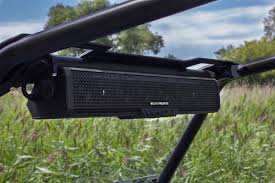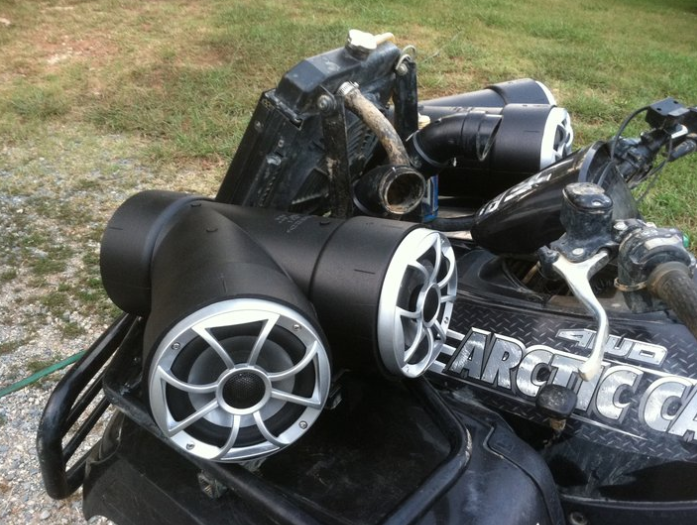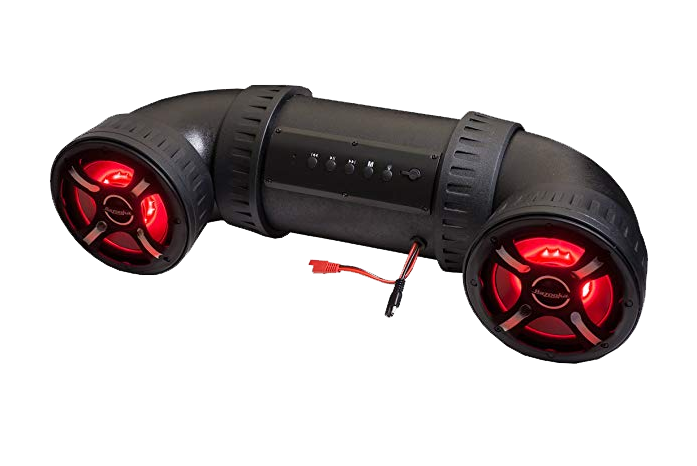A Guide to ATV Sound Systems
- Updated: January 28, 2020
If you are looking to build an ATV sound system from scratch, you need to have a sound understanding of audio equipment. We suggest you start by reading up on as much as literature as you can and watch DIY videos to acquaint yourself with the basics of building an audio system. You need to have a working knowledge of the components and their specifications. You need to study the layout of the vehicle to gauge what kind of gear would best fit it. You also need the right tools to install the gear.
In this article, we will attempt to answer some of the questions you might have regarding ATV/UTV sound systems. Do give it a read. Here we go.
Components of an ATV Sound System
Stereo receiver/head-unit/radio
The receiver is the main control station. It takes in the audio signal from the sound source, amplifies it and sends it to the speakers. A receiver, more often than not, contains a preamplifier and a power amplifier. Depending on the make it might have Bluetooth, Aux input, USB input, RCA line outputs, AM/FM radio, and controls for adjusting bass, treble and balance.

ATV/UTV Soundbar
Speakers
An ATV speaker is a rugged weatherproof loudspeaker resistant to water, dirt, sunlight, salt and impact. It has adjustable mounts for mounting to a range of roll cages and overhead bars. It is designed for ATVs, UTVs, ORVs and side-by-sides.
ATV speakers come in various configurations. Some are sold in pairs and some in sets of four. Some are shaped like tubes with all the drivers lined up inside a single long cabinet. Some are custom-made for specific ATVs. Custom-made systems have the flexibility to be upgraded to multi-channel systems.

Subwoofer
If you need extra bass, you can add an extra sub separately. ATV subs are high-output bass speakers with weatherproof cabinets.
Amplifier
If you want to add more speakers for a more spacious sound experience, you might have to hook up an additional amplifier. The amp in your receiver won’t be enough to drive the high-output speakers and you will the backing of an external amp.
Wires and cables
Audio cables will be required for connecting the components. You want to go in for weatherproof wiring since the cables would routinely be exposed to the elements.
Types of ATV Audio Sound Systems
Depending on the vehicle and the amount of money you are willing to spend, there are plenty of ATV sound systems you can choose from.
Receiver and speakers
The most common audio set-up involves a marine receiver and a pair of marine stereo speakers. It is sufficient for stereo sound and is pocket-friendly too. The receiver stays close to the dash for quick changes of volume and input. The speakers are secured to the overhead cage or tower tubes for maximum sound projection.
If you want bigger sound, you can add a second pair of speakers and an extra subwoofer. In that case, you will need an additional amplifier to power the speakers and the sub.
ATV soundbar or ATV audio tube
If you want a hassle-free solution with minimal wiring, we recommend an audio tube or an ATV sound bar. An audio tube is an all-in-one soundbar for off-road vehicles. It has tweeters, woofers and midrange drivers inside a single enclosure. It has an in-unit amplifier that drives the loudspeakers. It pairs with your devices via Bluetooth and also has AUX connectivity.

Custom-made audio kit
Now let’s talk about the newest sensation in ATV audio: custom-designed stereo system kits. These kits are super-specialized combos for ATV models like Polaris rangers, RZRs, Maverick and Yamaha YXZs. There are various brands that make these kits such as Rockford Fosgate and Pyle. The best thing about the kits is that they are available in stages. For instance, the Rockford Fosgate kit for the Can-Am Maverick X3 is available in 5 stages starting from a basic receiver-and-2-speakers configuration all the way up to a formidable multi-channel system with 4 speakers, 2 subwoofers and a 5-channel amplifier. It is up to you what configuration you prefer. You can start with an entry-level system and upgrade as you become more familiar with the parts and how they work. Good news is, almost all the parts are sold separately, so you can build the system at your own pace.
Audio roof
For people who spend a considerable part of their day in the sun, an audio roof might be a good idea. It protects you from the elements and offers booming loud music. It features a built-in receiver and 2 or 4 speakers. It has to be mounted to the vehicle and might require some drilling. Be it farm work or adventure sports an audio roof is an all-in-one solution for your ATV audio needs.
Other ATV Sound Gear
Sound system with LED light bars
If you are someone who frequently ventures into the woods after dark, we advise you to get a sound system with LED bars. You can buy the bars separately or buy a speaker with LED trim rings or an audio tube with a built-in LED light bar. The ones sold separately are more luminous; the integrated ones are less luminous but have multi-color lightshow with strobe effects. You can choose any type you like. The light from the bars keeps the dash area lit up. It is practical and safe when staying out late in the forest or desert. You can read maps, do small jobs, and in general, find your way around the dash quite comfortably without a flashlight.
ATV GPS system and 2-way radio
If you use your ORV for hunting, fishing or heavy-duty off-roading, you might want to consider installing a good GPS system. It is a pragmatic way to find your way around a place you are not very familiar with. It comes with built-in maps, and 3D and topographic displays for easy navigation. It is a marine-rated device that can take a beating and still keep you on the right track as you explore the wilderness. So, be sure to get one before you set off on your next expedition.
Things to Consider While Selecting ATV Sound Equipment
The other gadget we highly recommend for outdoor explorations is a 2-way radio. Frankly, there’s nothing quite like a weatherproof walkie-talkie system to stay in touch with the base camp or your travel companions. Whether you are in a desert, forest, grassland or glacier, a 2-way radio system is a must from a safety perspective. It can get you out of any situation, and therefore, is very essential.
Ingress Protection (IP) rating
The components of an ATV speaker system need to be able to stand up to the elements. The head-unit, the speakers, the subwoofer, the amplifier and even the wires need to have a high IP rating to survive harsh weather conditions. They need to be protected against rain, moisture, fog, dust, salt and splashes of water. Choose a speaker system that you can hose down after a long day in the trail. If you are going to be using the ATV in snow, make sure the equipment is resistant to snow and is capable of operating in sub-zero temperatures.
UV protection
All components of an ATV sound system must have anti-UV coatings to protect against the harmful rays of the sun. Sun damage can make plastic parts brittle. It can render sensitive internal parts like chips dysfunctional. It can cause discoloration and make your speakers look old and worn. Therefore, make sure you only buy UV-protected audio equipment.
Corrosion resistance
The ATV sound system must be able to withstand corrosion caused by wind, water, sun and atmospheric salts and acids. Since outdoor sound systems are constantly exposed to the elements, they age faster, and hence, need to be made from corrosion-resistant materials. Rust is a major issue. Make sure your mounting clamps, brackets and screws are fully rustproof.



